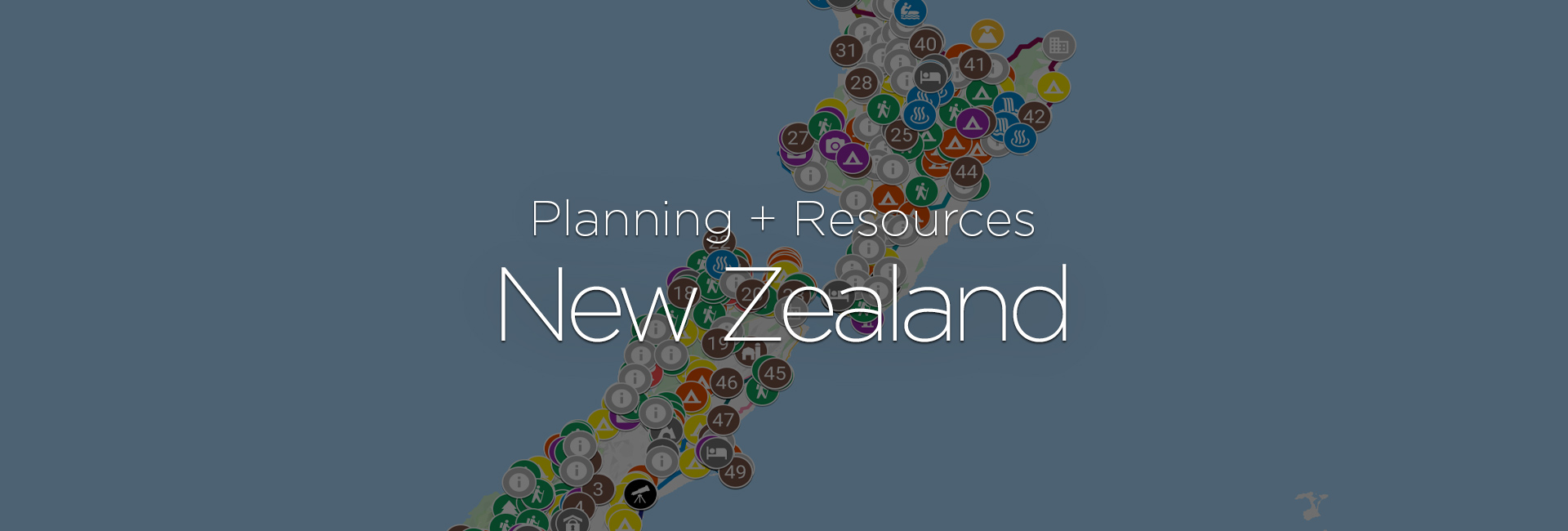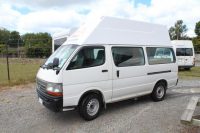Shhhh…. don’t tell our Camper Dan. We’re headed to New Zealand for four months to travel in our new campervan called Big D. Keep reading for New Zealand travel resources and planning tips.
UPDATE: We had planned on visiting New Zealand for four months in 2020. But, yeah, 2020 happened. This meant we spent closer to NINE MONTHS in beautiful Aotearoa. #eternallygrateful. New Zealand travelogue here.
Table of Contents
About New Zealand
New Zealand is comprised of two main islands – the North and South Islands – and another 600 or so smaller islands. It is roughly the size of the U.K. or the state of Colorado and has a population of approximately 5 million.
Aotearoa, translated as Land of the Long White Cloud, is the Māori name for New Zealand. The Māori have inhabited the islands since 1300 A.D. and European settlers began to arrive in the late 1700s. New Zealand is considered to be the last significant land mass to be settled.
The landscape of New Zealand is diverse. It includes mountains, fjords, pastures, beaches, and volcanic zones. The flora and fauna is equally unique with the nocturnal, burrowing parrot called the kakapo and the national symbol, the kiwi, which is also the name by which New Zealanders refer to themselves.
Random Fantastic New Zealand Facts
- New Zealand society is amongst the most secular in the world.
- Almost half of the energy supply of New Zealand is generated from renewable sources.
- New Zealand was the first country in which all the highest offices were occupied simultaneously by women.
- Fossils indicating human-size penguins once inhabited the land were discovered in 2019.
New Zealand Map with Points of Interest
This New Zealand map was created as a planning tool for our travels to New Zealand. The map has layers highlighting various points of interest, including all National Parks, UNESCO Sites, Great Walks, International Dark Sky Places, DOC campsites, iSites, and much more. The map has a description and/or link associated with most points. Visualizing the location of these points of interest assisted us in deciding upon a rough itinerary and route for our four month trip to New Zealand.
Our New Zealand Travel Objectives and Itinerary
Travel Objectives
Our New Zealand travel objectives include:
- Explore National Parks, UNESCO sites, and International Dark Sky Places.
- Learn about Māori culture.
- Immerse ourselves in nature; including experiences such as tramping (hiking) one or more Great Walks, black water rafting to view glowworms, heli-hiking, and more.
The New Zealand travel resources, guides, and tips listed herein reflect our priorities and objectives.
Itinerary
We have four months to explore New Zealand and are arriving and departing from Christchurch. Using our New Zealand map as a reference, we anticipate an itinerary comprised of approximately two months on the South Island followed by two months on the North Island.
We have laid out a tentative week-by-week itinerary but anticipate changes based on weather, work commitments, general levels of enjoyment, and the like.
We’ll post more about our planned vs. actual itinerary throughout our New Zealand adventures.
Curated New Zealand Planning Tips and Resources
New Zealand Travel Guides
- The New Zealand Tourism Bureau has a super comprehensive, user-friendly website. We used their site extensively. We plotted all the New Zealand themed highways on our New Zealand map to help inform our own route and itinerary.
- The New Zealand Department of Conservation (DOC) is another comprehensive website. We referenced the camping section for DOC campsite information and plotted each DOC campsite, as well as all the National Parks, on our New Zealand map. We also learned about the rental campervan campsite pass – a nice option if you rent instead of purchasing a vehicle. And we used the Great Walks section to learn about obtaining permits for the Great Walks.
- Information on New Zealand tramping (hiking) opportunities is plentiful online. General descriptions and photos can be found here and here. The New Zealand Mountain Safety Council and Adventure Smart websites are useful for safety measures and to register your hiking intentions. Detailed topographic maps can be found here.
- We’re also a fan of using the Lonely Planet travel guides as background and reference material. We purchased these two books:
- Shout-out to the many travelers that have documented their New Zealand adventures on their travel blogs! We normally like to call out those itineraries that were most helpful but we didn’t find many articles published for New Zealand travel with a stay greater than six weeks. We still enjoyed reading about the experiences of others and used it to supplement the official New Zealand tourism information.
New Zealand Travel Insurance
We typically use World Nomads for travel insurance when we travel internationally long-term. They often offer the best value and are super easy to work with, especially if you think you may want to extend a policy end date. You can get a quote using the widget on our Resources page.
However, for our New Zealand travels, we opted for the Prime Experience Family coverage offered by OrbitProtect. Their coverage is specific to New Zealand with allowance for some travel in other South West Pacific nations. Their offering was more extensive as well as cost effective for the coverage we most cared about (emergency evacuation, search and rescue, and personal effects). We paid 718 NZD for four months of coverage for the two of us.
For reference, the other providers we compared included World Nomads, SafetyWing, Allianz, Chubb, and AIG (TravelGuard). SafetyWing offers a subscription insurance policy for digital nomads – an interesting and novel concept – that we’ll be exploring in the future.
Entering New Zealand
Many visitors to New Zealand will only require an Electronic Travel Authority (ETA) and will not require a visa. However, due to our US citizenship and anticipated stay of four months, we require a New Zealand Visitor Visa. Learn more about your specific visa requirements here.
New Zealand Flights
The largest international airport in New Zealand is located in Auckland. However, the cities of Christchurch, Wellington, Queenstown, and Dunedin also have international airports. Major airlines offer direct flights to New Zealand from Australia, United States, Canada, China, Hong Kong, Singapore, Japan, Korea, Malaysia, Thailand, and Chile.
We have two stop-overs on our way to New Zealand. Each stop-over is for about a week and allows us to visit friends and family. We fly from New Jersey to California, California to Brisbane (Australia), and Brisbane to Christchurch. Each of these three flights were purchased with Chase Ultimate Reward points.
Our return flight from New Zealand to the United States was purchased with United miles.
Transportation in New Zealand
Having your own wheels is the most efficient way to explore New Zealand.
We knew we wanted to camp throughout our New Zealand journey – in either a tent or campervan – and investigated the following options (and permutations thereof):
- rent car + bring tent and camping gear
- rent campervan
- purchase car + bring tent and camping gear
- purchase campervan
Ultimately you’ll need to decide what suits your personality and schedule best. As basic guidance, hiring a campervan is popular and there are many agencies but it is significantly more expensive in the high season. Especially for a certified self-contained campervan. Hiring a car is less expensive but requires tent camping which subjects you to the whims of the weather and is also not allowed everywhere. Purchasing either a car or campervan can be more cost effective for longer trips (ask about a buy-back) but also means accepting the risks of ownership.
After creating a spreadsheet of rental companies, vehicle types, and prices, we scoured the sale boards to understand the purchase price and quality of available vehicles. TradeMe is the New Zealand online marketplace and physical car fairs are also popular. We also read the reviews and experiences of other travelers.
We ultimately opted to purchase a campervan and also bring a tent and camping gear for backcountry experiences. This decision was based on net cost, increased comfort in a campervan, and finding someone we trusted and liked to assist in the purchase process.
Our campervan will serve as both our transportation and our accommodation in New Zealand. Our new campervan has been affectionately called Big D (D for diesel) by the children of the folks who found us this campervan.
COMING SOON: After our travels, we’ll post about our decision to purchase a campervan, the buying process, our on-the-ground experience, and whether we recommend this option to other travellers.
TIP: Had we decided to hire a car we would have identified a rental car using AutoSlash – a website that searches for the best price on rental car reservations and will subsequently alert you if a better price is identified.
TIP: If you choose to forgo your own transportation, we like Rome2Rio to determine the best way to get from point A to point B worldwide.
Driving in New Zealand
- New Zealanders drive on the left hand side of the road in vehicles that seat the driver on the right. Additional tips for visitors are located on the New Zealand Transportation Agency website.
- An international drivers license is not required if you hold an English-language current drivers license.
- Car insurance is not mandatory. However, we plan on purchasing a policy from New Zealand Automobile Association to limit our liability. Travellers is another popular insurance company used by backpackers for 3rd party liability policies. Policies are also available over the phone from Kiwi Bank and the post office.
- Petrol is expensive. Use an AA Smart Fuel card to accumulate a discount to apply when refueling.
Camping in New Zealand
Our campervan, Big D, will serve as both our transportation and our accommodation. We anticipate a combination of freedom camping (as allowed, DOC campsites, and private land.
- Freedom camping is NOT permitted everywhere. Understand the regulations and view the restricted and prohibited areas by council district here.
- The New Zealand Department of Conservation manages over 200 campsites across New Zealand. Learn about the campsite classification system, associated facilities and fees on their website here.
- The DOC also administers the rental campervan campsite pass program – a nice option for discounted campsite fees if you rent instead of purchasing a vehicle.
- Okay2Stay and Campable both pair travelers and local hosts across New Zealand. Campsites are booked in a traditional manner with Campable. OK2Stay is suitable for self-contained campers only. It has a nominal annual membership fee in exchange for access to host information. It is expected that travelers purchase goods (wine, produce, cheese, etc) from hosts. We’re eager to experience these more personal and local accommodation options.
Helpful New Zealand Android / iPhone Apps
In addition to the standard apps we use, we’ve also downloaded the following New Zealand specific apps.
- Camping NZ: identify campsites, petrol stations, LPG refills, free wifi, and more; supports offline maps
- CamperMate: map with campsites, petrol stations, and points of interest for New Zealand and Australia
- Campable: book campsites on private land
- MetService: New Zealand’s designated National Meteorological Service
last updated: 19-Mar-2021

